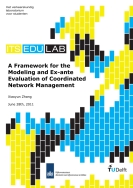Since the second half of last century, traffic congestion on road network has become a predominant phenomenon due to the rapid increases in transport demand and number of vehicles. It starts to become clear until later that century traffic congestion cannot be solved single-handedly by expansions of road network. During peak hours, besides recurrent congestion caused by insatiable demand, non-recurrent congestion caused by incidents, adverse weather conditions and work zones, are becoming more problematic with their temporary disturbances causing traffic breakdowns.
Developments and deployments of traffic control strategies come into effect to solve recurrent and non-recurrent congestions with a synthesis combining technologies, traffic theories, mathematics and kinematics. Although ITS control measures are relatively new, they transform into the backbones of a prevailing type of traffic management, Dynamic Traffic Management. When coordination and integration between DTM control measures is introduced as the advanced approach to restore the utilization of road network, great hope is placed on Coordinated Network Management to improve the effectiveness of traffic management. The Field Test Integrated Traffic Management Amsterdam aims at investigating the effect and the control concept of coordinated network wide traffic management for the implementation in 2013.
This report describes the development of an assessment methodology framework for modelling and ex-ante evaluation of CNM. The methodology framework is applied to the kidney shaped network of southern Amsterdam region in order to perform ex-ante evaluation on realizing and testing dynamic coordinated network management. Evaluations and validations of the above modelling are presented to show the effect of individual DTM and coordinated DTM, also known as CNM, under recurrent and non-recurrent congestions. A test solution towards advanced deployment strategies and methodologies based on an incident-induced empirical case is contrived later using Matlab. Simulation results are also presented in order to assess this test solution and the effect of CNM under its coordination strategies and methodologies. Finally, findings, conclusions, recommendations and future directions are drawn to bring the thesis project to completion. This thesis is relevant for the future implementation of CNM in the PPA project and it is informative to other CNM related researches.
